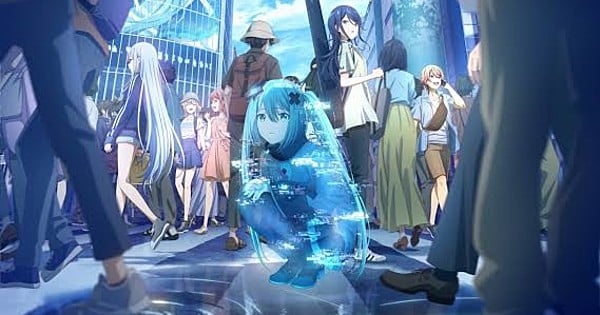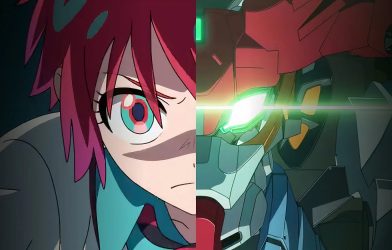While far from the biggest Hatsune Miku fan, I’d dare to claim I am “familiar” with the franchise. I have played several Project Diva games, listened to more than a few Vocaloid songs, seen her “live” at various events, and even played around with the music-making software a bit. If you are like me, I can confidently say… this isn’t a movie made with you in mind. Rather, COLORFUL STAGE! The Movie: A Miku Who Can’t Sing is a movie made for one group of people and one group only: Players of the smartphone game Hatsune Miku: Colorful Stage.
This film spends no time on pesky little things like “explaining the setting” or “introducing the characters”—which turns out to be a problem in a film like this one. It took me half the film to figure out the basic concept of the world: that various groups of young musical artists across different genres can enter their own secret pocket realities complete with their own separate versions of Miku and friends. Even excluding the various Vocaloid character variants, the five bands featured prominently in the film mean that there are over 20 human main characters to keep track of—and the film has no issue switching between them seemingly at random.
To say that it’s a lot to take in all at once is more than an understatement. Even after watching the film from start to finish, I can’t remember a single name or anything about them beyond their physical appearance or trademark one-note quirk off the top of my head. Of course, those who have extensively played Hatsune Miku: Colorful Stage would likely not face these issues; they’d already be familiar with the world and characters—and seeing them in all their animated glory would almost certainly be a rare treat. This is what I mean when I say the film is for the smartphone game players rather than your average Miku fan.
However, that’s not to say the film is impenetrable. The plot is rather straightforward. Rather than focusing on any specific band’s Miku, each of them (unbeknownst to the others), encounters a new Miku—one from a broken world with no human guests. This Miku has been attempting to reach out to humans who need her—to make them feel like they are not alone through her songs—only to appear as garbled static on their screens. When she encounters the various bands, she tries to get each to teach her to emotionally connect to people through her music like they all do, hoping she can one day do the same.
Thematically, the film is about reaching out to those who need help—and how those people often push those around them away. Giving up on a dream can be incredibly lonely and while Broken-World Miku is earnestly trying to connect—to let these people know they are not alone—you can’t help those who don’t want it. It needs to be the right person at the right time reaching out to have any chance of success. Luckily, while Broken-World Miku herself may be unable to succeed on her own, she has five groups of new friends eager to help.
It’s safe to say that music is a core aspect of what it means to be human. It connects to each of us on an emotional level and can alter our moods in ways few other things can. However, it is also deeply tied to personal tastes. A song may deeply resonate with one person while sounding like a derivative drivel to another. Thus, the climax of the film involves each band taking Broken-World Miku’s song, and building their own song around it—attempting to convey her song’s message in their own words and musical style.
What we get from this is the musical highlight of the film. We get an interpretation of Miku’s song in the styles of hip-hop, idol music, hard rock, children’s music, and a traditional Vocaloid music video. It is impressive—especially given the fact that the film is filled with great music (as you’d expect from a Hatsune Miku project of any type).
On the visual side of things, this isn’t the be-all-end-all best-looking anime P.A. Works has ever put out but that doesn’t mean it doesn’t look darn good. The animation contains a high level of detail and does a great job at showing both the real world and the various Miku pocket worlds. There’s a fantastic use of light and shadow and character designs are distinct enough that, despite the massive cast, it’s impossible to confuse one character for another.
What stands out the most is the aforementioned musical climax of the film. In many similar anime, the big concert scene switches from traditional 2D to 3D animation to perfectly reproduce the singers’ movements. However, this film retains the 2D animation look throughout—even in this massive scene with complex dance choreography and creative camera work. It’s impressive and not something I expect to see in modern anime.
In the end, COLORFUL STAGE! The Movie: A Miku Who Can’t Sing, is a film with great animation, superb music, and a straightforward, thematically poignant plot—that shoots itself in the foot with its utter refusal to throw a bone to anyone who hasn’t played Hatsune Miku: Colorful Stage. I honestly envy players of that game who get to watch this film. Going in with a full understanding of the world and character backstories must make this film so much more enjoyable. However, juggling more than 20 new characters while trying to figure out the rules of the world on the fly… that’s a bit too much to ask of your average viewer. Still, if nothing else, I’d recommend picking up the soundtrack for this film; it really is that good.









